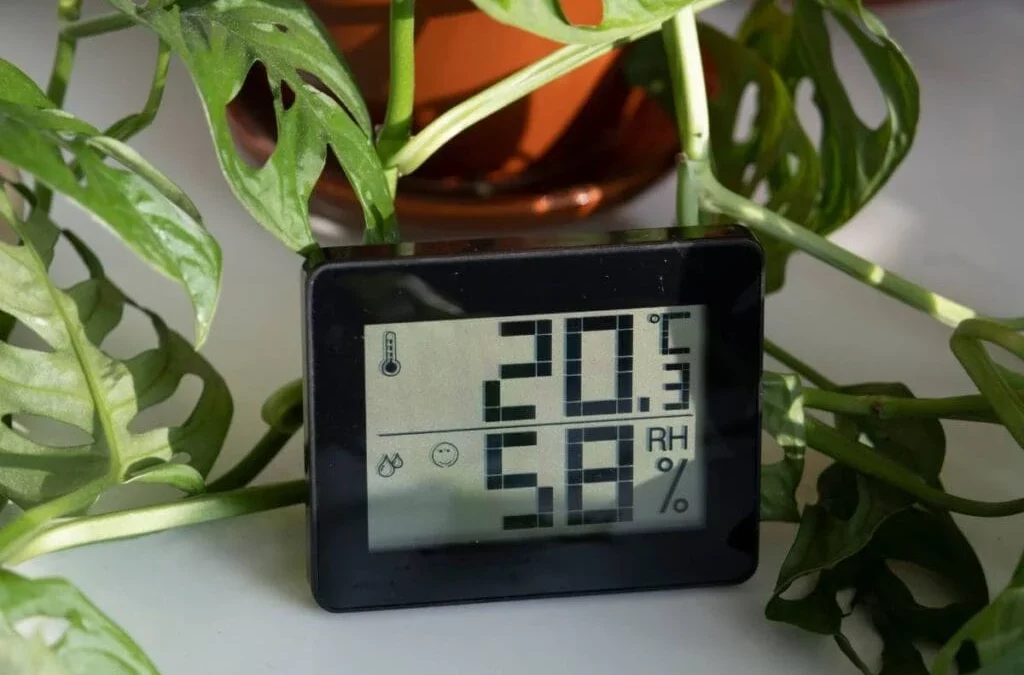Contents
- 1 The Best Temperature Range for Indoor Plants (Stay Healthy All Year)
- 1.1 Why Temperature Matters for Indoor Plants
- 1.2 Ideal Temperatures by Plant Type
- 1.3 Common Signs Your Plant Is Too Cold
- 1.4 Dangers of Overheating
- 1.5 Maintaining Stable Temperatures Year-Round
- 1.6 How Humidity and Temperature Work Together
- 1.7 Related Articles
- 1.8 Final Thoughts on Temperature and Indoor Plant Health
The Best Temperature Range for Indoor Plants (Stay Healthy All Year)
If your plants have been drooping, yellowing, or refusing to grow, the problem might not be water or light — it could be temperature.
Most indoor plants thrive within a specific temperature range, and even small fluctuations can cause stress. Knowing what your plants prefer can make the difference between constant struggle and year-round health.
Let’s break down how temperature affects growth, the ideal ranges for common plants, and simple ways to maintain a stable environment indoors.
Why Temperature Matters for Indoor Plants
Temperature affects everything — from how plants absorb water to how quickly they photosynthesize. When it’s too cold, growth slows, roots struggle, and leaves may drop. Too much heat can cause wilting, dehydration, and leaf scorch.
Since most popular houseplants originate from tropical and subtropical regions, they prefer warmth and consistency. Rapid temperature changes are what harm them most.
In general:
Most indoor plants thrive between 18–24°C (65–75°F) during the day.
Nighttime temperatures should stay around 15–18°C (59–65°F).
If your room regularly falls below 13°C (55°F) or rises above 29°C (85°F), your plants may begin to show stress symptoms like curling leaves, slow growth, or browning edges.
👉 For a deeper look at how indoor climate affects growth, see The Spruce’s temperature guide for houseplants.

Ideal Temperatures by Plant Type
Different species have different preferences. Here’s a quick overview of the most common indoor plant categories and the ranges they enjoy:
| Plant Type | Ideal Temperature Range (°C) | Notes |
|---|---|---|
| Tropical plants (Monstera, Peace Lily, Calathea) | 18–26°C | Avoid cold drafts or sudden drops. |
| Succulents & cacti | 15–24°C | Prefer drier air and slightly cooler nights. |
| Ferns (Boston, Maidenhair) | 18–23°C | Sensitive to dry air — maintain humidity. |
| Orchids | 18–25°C | Cooler nights encourage blooming. |
| Herbs (Basil, Mint, Rosemary) | 17–25°C | Keep near bright light and away from windows in winter. |
💡 Pro Tip: Always check the natural origin of your plant — tropical species dislike cold more than Mediterranean or desert types.
Common Signs Your Plant Is Too Cold
Plants often show early warning signs when temperatures drop below their comfort zone:
Yellowing or falling leaves
Stunted or no new growth
Soft or mushy stems
Soil that stays wet for too long
If this happens, move the plant away from drafty areas like doors, windows, or unheated rooms. Grouping plants together also helps retain warmth through shared humidity.
Recommended product: The ThermoPro Indoor Thermometer and Hygrometer on Amazon gives real-time readings of temperature and humidity — ideal for monitoring plant conditions in different rooms.
Dangers of Overheating
While cold air slows growth, excess heat can be just as harmful. Plants placed too close to radiators, fireplaces, or sunny glass can dry out quickly.
Overheating symptoms include:
Curling or crispy leaf edges
Drooping even after watering
Brown spots caused by heat stress
To prevent overheating:
Keep plants at least 1 metre from heaters.
Use blinds or sheer curtains during intense midday sunlight.
Increase humidity with a tray of pebbles and water underneath pots.
Recommended product: The Levoit Cool Mist Humidifier on Amazon maintains a stable environment and prevents leaf dehydration in heated rooms.
Maintaining Stable Temperatures Year-Round
Fluctuations — not extremes — are what harm most plants. Maintaining balance throughout the year keeps your collection healthy and stress-free.
Simple ways to regulate temperature:
- Use thermometers in multiple rooms to track microclimates.
- Seal window gaps to prevent cold drafts in winter.
- Avoid sudden moves — don’t relocate plants from cool rooms to warm spots too quickly.
- Control airflow by using fans gently during summer to prevent heat pockets.
- Switch grow light timers to shorter hours in winter and longer in spring.
💡 Pro Tip: Bathrooms and kitchens often hold steady humidity and temperature, making them great for tropical plants during cold months.
How Humidity and Temperature Work Together
Temperature and humidity go hand in hand. Warm air holds more moisture; when the air cools, humidity drops — that’s why plants dry out faster in winter.
To balance both:
Keep your home at a comfortable 40–60% humidity range.
Mist tropical plants early in the day if air feels dry.
Use a smart hygrometer to track changes automatically.
The SwitchBot Smart Hygrometer on Amazon syncs to your phone, helping you adjust humidity before it impacts your plants.
Related Articles
- How to Keep Indoor Plants Alive During Winter
- How to Improve Indoor Plant Drainage
- How to Create the Perfect Watering Schedule for Indoor Plants
Final Thoughts on Temperature and Indoor Plant Health
Stable temperature is one of the most overlooked factors in houseplant care.
By keeping your home within a consistent 18–24°C range, avoiding drafts, and maintaining proper humidity, your plants will reward you with lush growth and resilience all year long.
Healthy plants aren’t just about sunlight or watering — they’re about creating the right environment. Master temperature balance, and you’ll have thriving greenery no matter the season.

